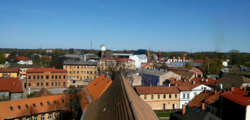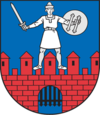CESIS
| Cēsis | |||
|---|---|---|---|
| Town | |||

Cēsis skyline
|
|||
|
|||
| Location in Latvia | |||
| Coordinates: 57°19′N 25°16′E / 57.317°N 25.267°ECoordinates: 57°19′N 25°16′E / 57.317°N 25.267°E | |||
| Country |
|
||
| District | Cēsis municipality | ||
| Town rights | 1206 | ||
| Government | |||
| • Mayor | Jānis Rozenbergs | ||
| Area | |||
| • Total | 19.28 km2 (7.44 sq mi) | ||
| Population | |||
| • Total | 18,065 | ||
| • Density | 937/km2 (2,430/sq mi) | ||
| Time zone | EET (UTC+2) | ||
| • Summer (DST) | EEST (UTC+3) | ||
| Postal code | LV-410(1-3) | ||
| Calling code | +371 641 | ||
| Number of city council members | 11 | ||
Cēsis (Latvian pronunciation: [tseːsis]), (German: Wenden, Livonian: Venden, Estonian: Võnnu, Polish: Kieś) is a town in Latvia located in the northern part of the Central Vidzeme Upland. Cēsis is on the Gauja River valley, and is built on a series of ridges above the river overlooking the woods below. Cēsis was one of the candidate cities for the title of European Capital of Culture 2014 (Riga was the Latvian city that won the title).
The oldest settlement in Cēsis is the hill fort on Riekstu hill, a fortified wooden castle built by a tribe known as the Vends. The 18-metre-high (59.06 ft) mound with its partly preserved fortification system can still be seen in the Castle Park. This settlement was located near major trade routes from west to east and dominated the regional countryside.
German crusaders known as the Livonian Brothers of the Sword began construction of a castle Wenden near the hill fort in 1209. When the castle was enlarged and fortified, it served as the residence for the Order's Master. In 1577, during the Livonian War, the garrison destroyed the castle to prevent it from falling into the control of Ivan the Terrible, who was decisively defeated in the Battle of Wenden (1578). In 1598 it was incorporated into the Polish–Lithuanian Commonwealth and the Wenden Voivodeship was created. In 1620 Wenden was conquered by Sweden. It was rebuilt afterwards, but destroyed again in 1703 during the Great Northern War by the Russian army and left in a ruined state. From the end of the 16th century, the premises of the Order's castle were adapted to the requirements of the Cēsis castle estate. When in 1777 the Cēsis castle estate was obtained by Count Sievers, he had his new residence house built on the site of the Eastern Block of the castle, joining its end wall with the fortification tower. Since 1949, the Cēsis History Museum has been located in the New Castle on the Cēsis Castle estate. The front yard of the New Castle is enclosed by a granary and a stable-coach house, which now houses the Exhibition Hall of the Museum. Beside the granary there is the oldest brewery in Latvia — Cēsu Alus, which was built in 1878 during the latter years of Count Sievers' residency, but its origins date back to the period of the Livonian Order.
...
Wikipedia



